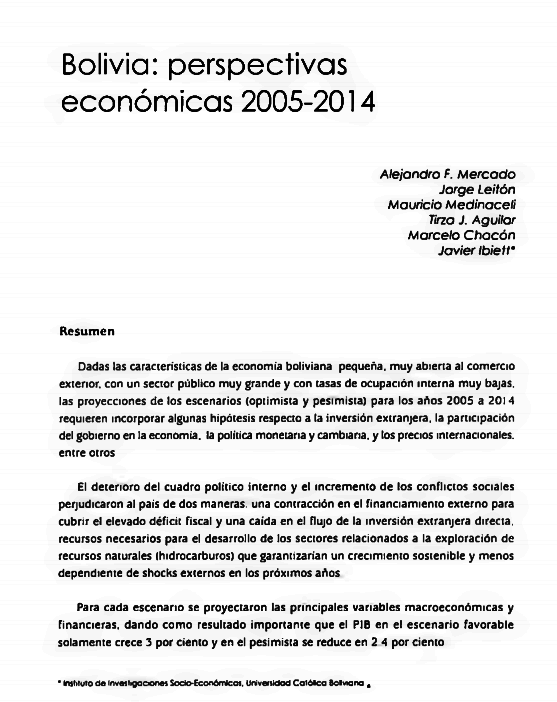Bolivia: economic perspectives 2005-2014
DOI:
https://doi.org/10.35319/lajed.20055251Keywords:
Bolivian economy, Monetary policyAbstract
Following the features of the Bolivian economy: small and widely open to the international markets, with a vast public sector and high unemployment rates; the forecasting of two economic scenarios (optimistic and pessimistic) for the period 2005-2014, includes specific hypotheses about the Foreign Direct Investment, Government Size, Monetary and Exchange Rate Policies and International Commodity Prices behavior.
The crisis within the Bolivian political schemes and the increased social unrest episodes, constituted a hindrance to the country’s economy in two ways: a narrowing of foreign financing in order to balance the public sector deficit and, a reduction of foreign direct investment; both of them are necessary sources for the development of natural resources' exploration (hydrocarbons) which will help to guarantee a sustainable growth and a self insurance against foreign economic shocks.
For each scenario, there were forecasted the main macroeconomic and financial variables, and the paper findings points out to an economic growth of 3 and 2.4 per cent in the optimistic and pessimistic scenarios respectively.
Downloads
References
Aguilar, Tirza J. (2003) Manual del Modelo de Equilibrio General Computable para Bolivia: simulación de políticas en GAMS. Tesis de grado de Economía, Universidad Católica Boliviana
Antezana, Oscar (1988) Análisis de la Nueva Política Económica. Editorial Los Amigos del Libro. La Paz, Bolivia
Ayala, Roberto y Soto José. (2002) “Caracterizando el Crecimiento Económico de los Países Miembros del FLAR” Fondo Latinoamericano de Reservas Documento de trabajo 02/01. Bogotá, Colombia.
Cariaga, Juan (1996) Estabilización y Desarrollo. Editorial Fondo de Cultura Económica. Los Amigos del Libro. La Paz, Bolivia
Chumacero, R. y Quiroz, J. (1996) “La tasa natural de crecimiento de la economía chilena: 1985 – 1996” Cuadernos de Economía. Departamento de Economía, Universidad de Chile.
Dunkerley, James (1987) Rebelión en las Venas. Segunda Edición, 2003, Plural Editores, La Paz, Bolivia.
Fondo Monetario Internacional (FMI). 2004. “ World economic Outlook": Advancing Structural reforms. World Economic and Financial Surveys
Kydland, F. y Prescott, E. (1982) “Time to build and aggregate fluctuations”. Econometrica Vol. 50 Evanston, IL. EE.UU.
Leitón, Jorge G.M. (2000) “Shocks de términos de intercambio y la balanza comercial” Universidad Católica Boliviana ‘San Pablo’, Departamento de Economía, Tesis de Titulación Nº 530, Noviembre, 2000, La Paz. Bolivia.
Lucas, Robert (1977) “Understanding Business Cycles” Carnegie-Rochester Conference Series on Public Policy, 5. Ronchester, NY. EE.UU.
Mercado, Alejandro F., Andersen, L., Medinaceli, M., Nina, O. (2003) “Movilidad Social: la clave para el desarrollo. Una agenda de políticas para la nueva década”. Programa de Investigación Estratégica en Bolivia (PIEB). La Paz, Bolivia.
Mercado, Alejandro F. (1999) “Bolivia: 1985 – 1999. Del Estatismo a la Economía de Mercado” en El Desenvolvimiento de la Economía Bolivia en el Siglo XX. Coord. Napoleón Pacheco. Ediciones Nueva Economía. La Paz, Bolivia
Mercado, Alejandro F. (1998) “Crecimiento Económico (Silogismos y paralogismos)” en Reflexiones Sobre el Crecimiento Económico. Fundación Milenio. La Paz, Bolivia.
Perron, Pierre (1989) “The Great Crash, The Oil Price Shock and the Unit Root Hypothesis” Econometrica, 57. Evanston, IL. EE.UU.
Thiele, Rainer y Daniel Piazzolo (2002) "Constructing a Social Accounting Matrix with a distributional focus: The case of Bolivia”. Kiel Institute for World Economics
UDAPE (2005) Dossier estadístico 2004
Zivot, Erick y Donald, Andrews (1992). “Further Evidence on the Great Crash, the Oil Price Shocks, and the Unit-Root Hypothesis” Journal of Business & Economic Statistics, 10. Alexandria, VA. EE.UU.






